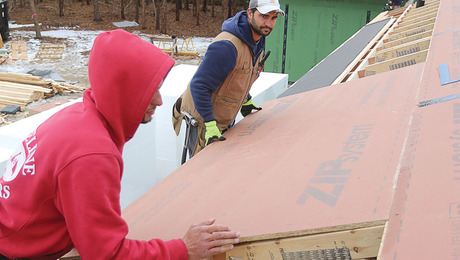Feeding outdoor outlet from A/C disconnect
Is there a legal (and safe) way to take power from an air-conditioner disconnect box?
The box is fed with three-conductor-plus ground, 240 V, 30 Amps (#10 Conductors). The A/C compressor uses about 6 amps when running.
What size cable should I use to tap power from the disconnect box if I want to power a 15-amp outdoor GFCI? Should I use #14 or #10 cable?
Thanks,
Vince















Replies
At the very least you'd have to have some sort of a fuse/breaker, to limit current to 15-20A. No doubt there are other issues as well.
Feeding outdoor outlet from A/C disconnect
It is also highly unlikely that there is a neutral present at this disconncet. If not then there is no logical way to do it.
A new wire must be run to the receptacle.
Well, he said there's three-plus cable (though I find that a bit odd for an AC feed).
Feeding outlet from A/C disconnect
Dan and Speedy:
Thanks for the replies. The cable is indeed three conductor plus ground (so there's a neutral). It's there because 40 years ago when I installed the A/C, I thought that 240 volt lines HAD to be like that. (Live and learn, but now I'm glad I made the mistake.)
So I guess the remaining question is: does the cable from the 30A disconnect to the 20A breaker need to be #10, or will #12 be OK? Can the "breaker" be a GFCI outlet, or should it be a "real" GFCI breaker?
Thanks again,
Vince
You need to have a real breaker/fuse (in addition to the outlet being a GFCI outlet) -- a GFCI outlet is not an "overcurrent protection device". Generally you'd put in a 20A breaker/fuse and a 20A GFCI outlet. Under some circumstances (limited distance, ending directly at an overcurrent device, etc) you can use wire rated for the overcurrent device (ie, #12) between your source and the overcurrent device. But I don't know chapter and verse.
Hmm... I could have sworn I posted on this thread a few hours ago ...
Short version is: it's probably a very bad idea.
Issue #1 is the neutral. Is there one? You need one - and I mean a white wire going all the way back to the panel. Accept no substitutes.
Issue #2 is overcurrent protection. The existing wires are probably on a 30-amp breaker; you need your receptacle on a fifteen or twenty-amp breaker.
Issue #3 are your connections. I doubt the disconnect terminals are intended to have two wires under them. Nor are there any places for the neutral wires to connect. Wire nuts? Probably don't have room for the connection, as well as the required pigtails.
If you do have a neutral, you can replace the disconnect with a small panel, and feed everything from there. I you don't know how to do that, hire it out.